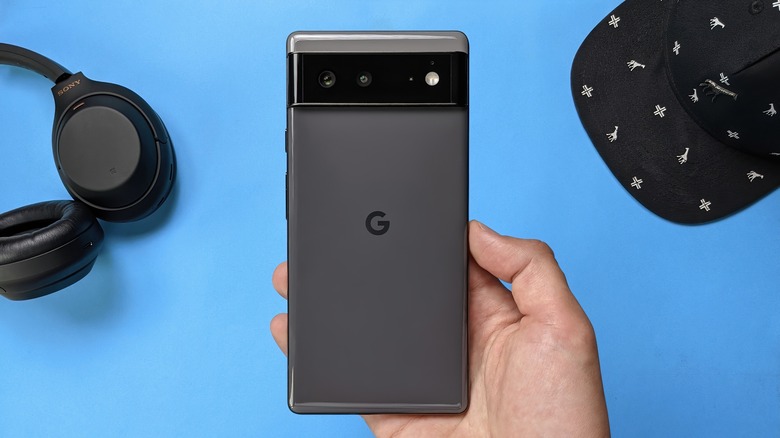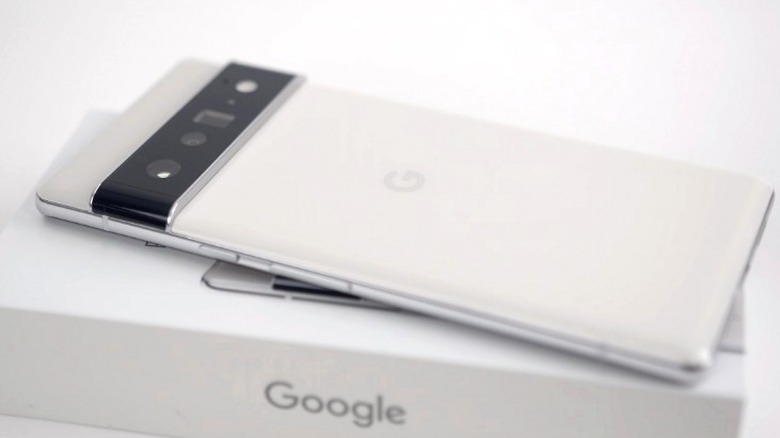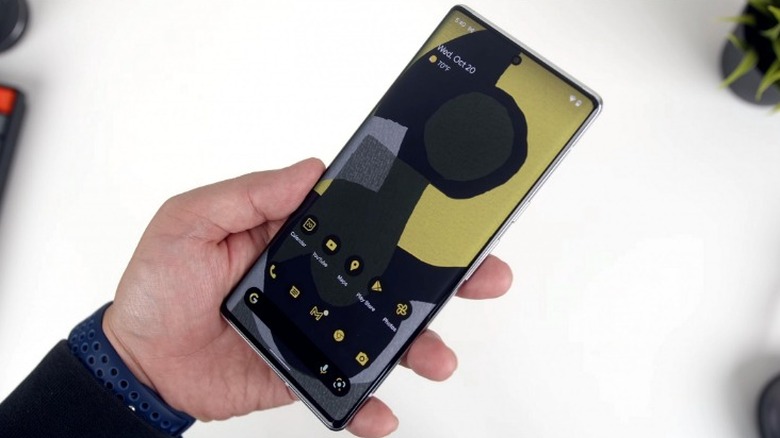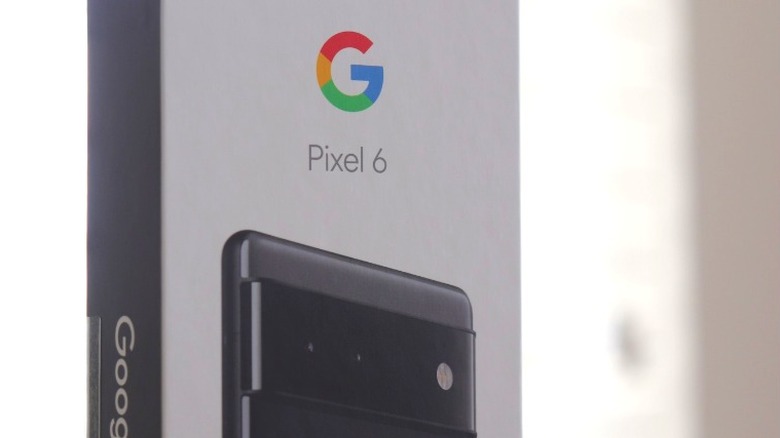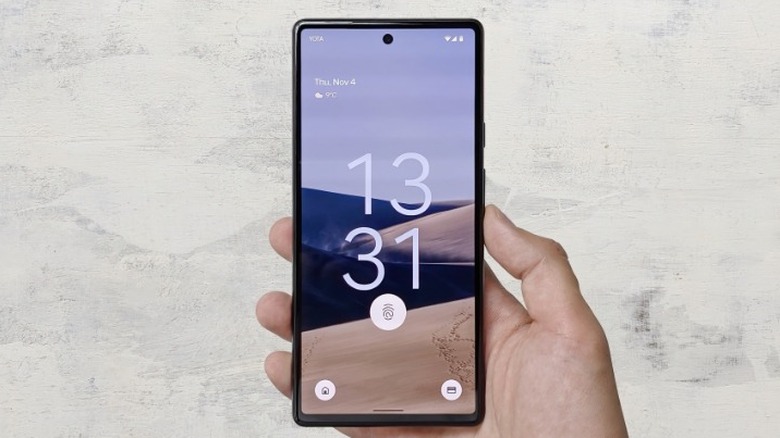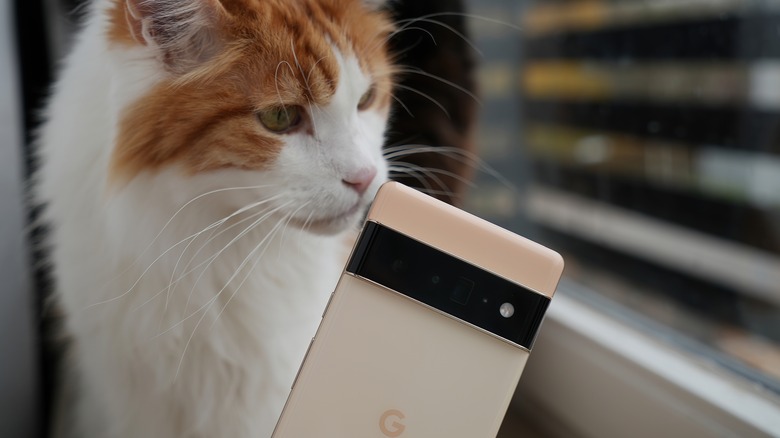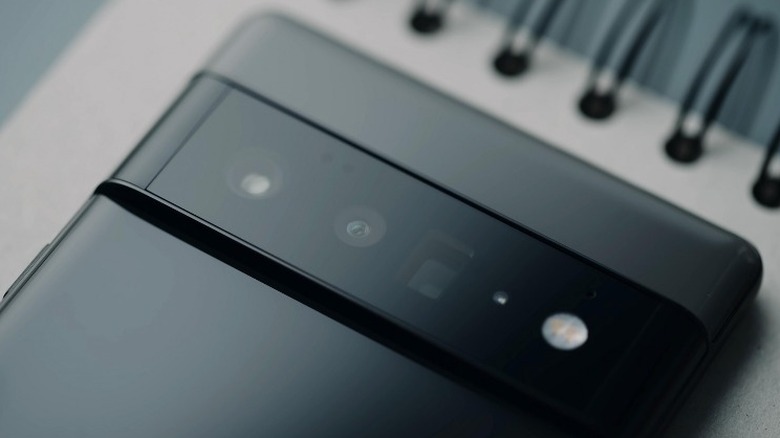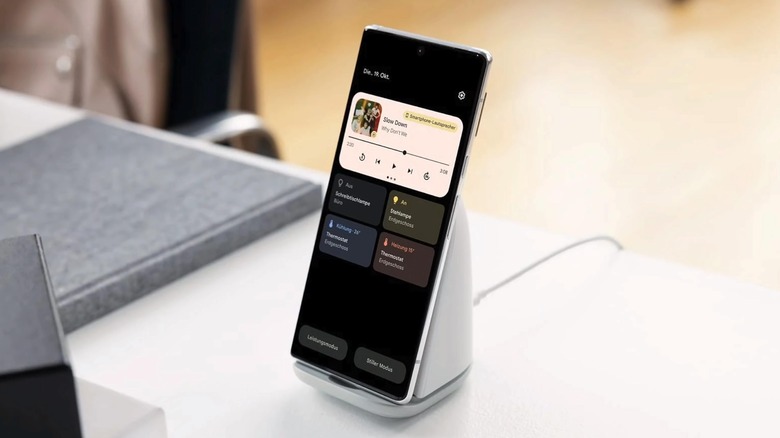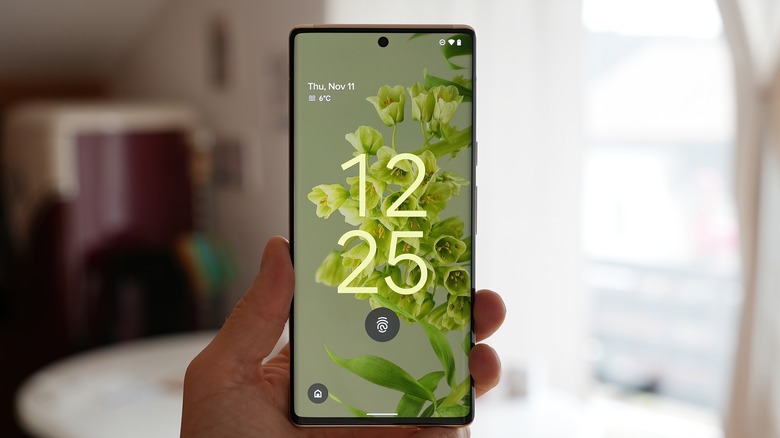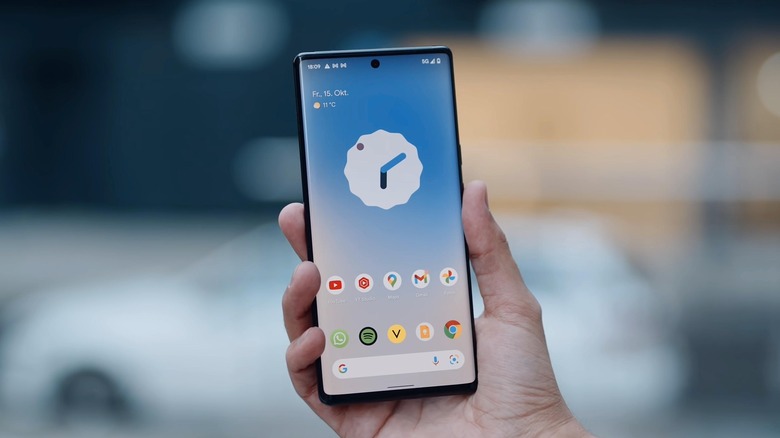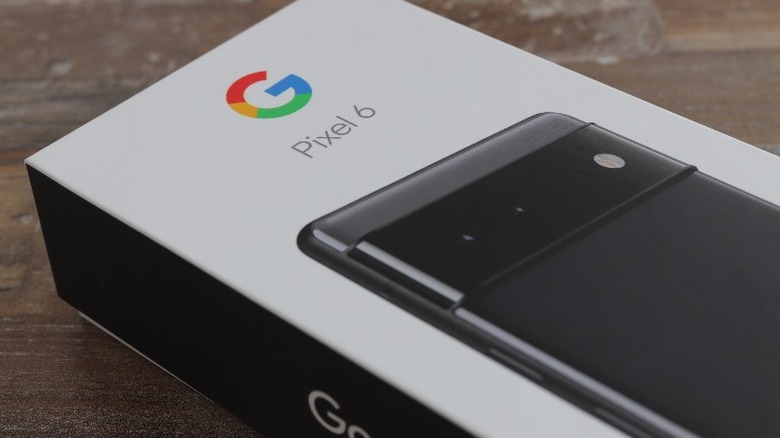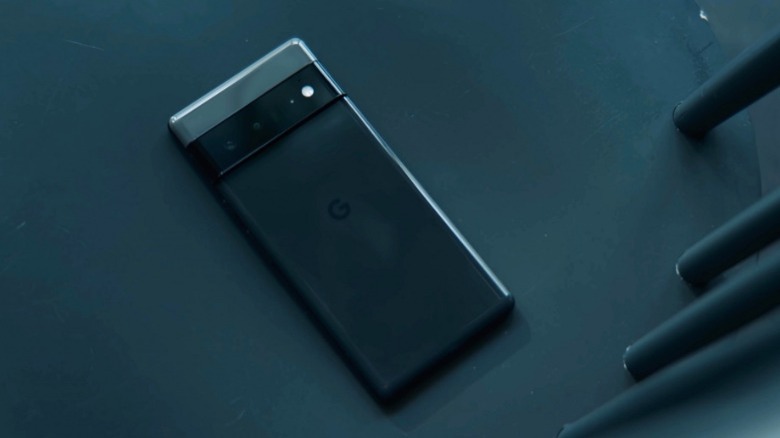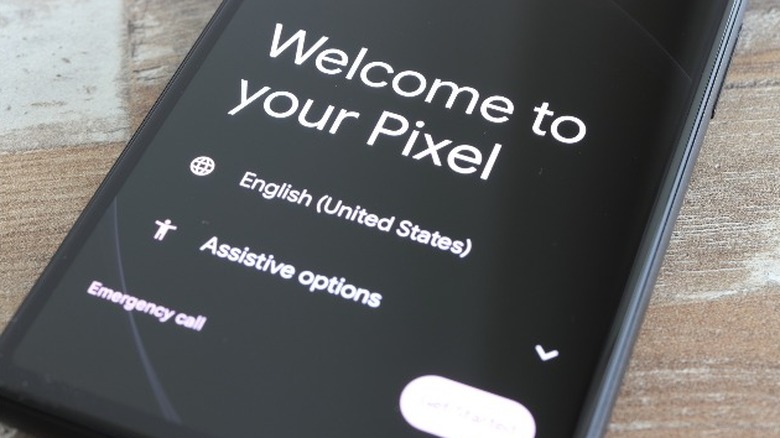Things You Never Knew Your Google Pixel 6 Could Do
The smartphone market is highly competitive and fast-moving. Technology changes at what seems like every minute, with developers and manufacturers working to come up with the next best feature and clever gimmick to get even the slightest edge over the competition. While Apple has dominated the space since the arrival of the iPhone, others have worked hard to match, and even exceed Apple's allure. Samsung has created flagship products with comparable stats running on the Android operating system, and has dominated that space for some time. Google, which is responsible for the proliferation of the Andriod system, has also dabbled in the hardware side of things, with several phone releases over the past decade or so.
Starting in 2016, Google decided to step up its game making smartphones with the release of the Google Pixel (via Phone Arena). It has since evolved to the current Pixel 6, a phone sporting impressive features. Chris Burns reviewed the Google Pixel 6 for SlashGear, giving it high marks and complimenting its excellent combination of delivering powerful hardware with impressive software at an affordable price. Dig into the specifics, and you will find a seemingly endless array of features and functions to enhance the user experience. And for anyone who gets the opportunity to spend some time with one, here are a few tricks you may not know the Google Pixel 6 could do.
Quick Tap
Manufacturers have been finding creative ways to get rid of buttons on phones, both hard and soft. Most recently, many functions once handled by an on-screen button of some sort have been eliminated in favor of using gestures, providing more screen space. However, gestures are not always the most convenient manner to execute a task. Google has thought of a clever way around this: the Quick Tap.
Disabled by default, Quick Tap is accessed through the settings, and can be customized to suit your needs. It works by performing a simple double tap on the rear of the phone. The settings menu provides several possible functions, such as activating the flashlight, playing and pausing media, or showing notifications. Perhaps the best feature is that it can be connected to an app of your choosing, offering endless possibilities of what to do with it. It also has a setting requiring stronger taps to avoid inadvertent triggering of the function (via Android Authority).
Enhanced Auto-Rotate
Auto-rotate is nothing new, nor is it unique to the Pixel. It's an integral part of most functions on the phone. When your phone is flipped, the screen rotates accordingly. But Google has taken this integral feature and enhanced it to take care of what can be a fairly annoying experience with the rotation.
Phones are generally designed to be used while the user is upright. But we all know that is not always how phones are used. It can often be a bit annoying when lying down to watch a video, and the screen tries to rotate the wrong way to see the video appropriately. Google has remedied this situation by enabling its front-facing camera to recognize the orientation of your face. That way, it ensures the screen is rotated appropriately for proper viewing (via Chrome Unboxed). It is a small tweak to the function, but a clever one that should prove to be helpful, at least in some situations.
Notification History
Sometimes, new features on phones can feel as though developers are adding things just for the sake of having something to add. The new Notification History may be one of those features. However, it is not without its merits, and it provides another user-friendly element to the Google Pixel 6.
Depending on how the phone's settings are configured, some people may experience rapid-fire notifications that can inundate the user and become distracting. For those occasions where the user has dismissed a notification and wants to retrieve it later, Notification History makes that possible. The history is stored under the notifications menu in settings. The history only stores notifications for 24 hours. After that, they are deleted permanently.
To note, Notification History only shows notifications that have been dismissed, and doesn't show any incoming or present notifications (via 9to5Google). Still, it's a useful feature for those who don't have the time or don't like to open every single notification as it arrives.
Voice Typing
One of the most useful tools on a modern smartphone is the ability to type simply by speaking, transporting us all into the "Star Trek: The Next Generation" world envisioned decades ago. While touch screen keyboards are much better than they used to be, and offer good accuracy and speed, digital dictation can eliminate further frustrations. This tech has been available for many years now, and it's utilized by phones across the spectrum of price and quality. But the Pixel 6 with Google's new Tensor microchip is better.
According to Android Police, Google has proclaimed the Tensor to enable the "most advanced speech recognition" available, and has put forth considerable effort into developing this function. Speech recognition on the Pixel 6 is capable of picking up nuance in language, and can accurately predict the desired text at a remarkable speed. Apparently, creating good speech recognition has been a desire of Google for some time, and this newest iteration of the Pixel phone showcases the fruits of that hard work.
Magic Eraser
Having cameras in our pockets at all times has a dramatic impact on society, making it exceedingly convenient to capture intimate moments, as well as keep public officials accountable. Furthermore, the quality of the built-in cameras has advanced to a level that images are virtually indistinguishable from those taken by high-end cameras not so long ago. Sadly, no matter how good a camera is, it cannot make up for the lack of photography skills of its user. For those little photographic mistakes, we have the Pixel 6 Magic Eraser.
Standard in the suite of features on the Pixel 6, Magic Eraser uses AI to find elements in a photo that may be unwanted, and generates suggestions to the user for removal. It requires almost no effort or skill from the user. The app highlights things such as people in the background, and allows the user to tap those things that are unwanted to be removed. The phone then approximates what should be in the place of the removed artifact, and fills it in (via Google). It is nearly effortless, works surprisingly well, and should prove to be an indispensable tool for any Pixel 6 owner.
Camera Quick Launch
This is hardly a novel feature, but it may not be all that well known to anyone who fails to fully avail themselves of the introductory tutorial included with the phone. You know who you are.
The Google Pixel 6 comes preset to open the camera app with a simple double-tap of the power button. It even works when the phone is locked, providing quick access to the camera. This is an extremely helpful feature for capturing those once-in-a-lifetime moments that can pass in an instant. It can also be a handy tool when confronted by a situation that merits documentation of bad behavior, or evidence of a crime.
Note that this quick-launch feature only opens the camera; it does not bypass the phone's lock screen. If you want to use your phone's other features, or even close the camera app, you'll need to unlock it (via How-To Geek).
Face Unblur
Having advanced cameras is great for our casual photography, but that does not mean we are all great photographers. Furthermore, good photo editing software is expensive and complicated to use. That means the amateur photographer usually needs to take several shots to ensure a good picture. However, the Pixel 6 can help.
Google's machine learning is packed in throughout the Pixel, and much attention has been paid to the camera. One of the newest features is Face Unblur. Again, Google has built capability into its Tensor chip to improve your photos. Face Unblur recognizes faces, and can clean up an image to sharpen a blurred face. Remarkably, this is not an option or a setting that must be turned on; it repairs photos automatically with no input from the user.
Android Police says that this effect is achieved by using both cameras to pick up, and then correct, the image through data acquired. Regardless, the result is better pictures with minimal effort.
Live Translate
The ability to carry a universal translator in our pockets has given travelers a fantastic tool in aiding navigation of foreign lands. Even with the somewhat clunky interfaces already installed on smartphones, it can make life much easier in other countries. However, these interfaces are imperfect, and often suffer from significant lags. Google has addressed this again through its new Tensor chip in tweaking its translation ability on the Pixel 6.
The really clever bits about Live Translate are present in its name, live. With Google Assistant, users can call up Live Translate, say what language they want to translate to, and then speak. The Pixel will not only speak the translated words, but also display the text on-screen along with alternate translations to account for the nuances of languages, and possible idioms being used. Pixel 6 does this action extremely fast due to the Tensor chip installed, and also needs no internet connection to work (via Android Police).
Real Tone
There exist long-standing issues for people of color related to getting properly represented in photographs. These issues go back almost as long as photography has existed. Getting pictures developed that accurately represents darker skin tones is the struggle that persists to this day. The New York Times reported that this issue stems from the use of a picture of a white woman as a reference point, and ignoring the existence of other skin tones. Furthermore, it was not until manufacturers of chocolate and furniture complained that Kodak made efforts to get their new color films to properly represent darker tones.
Google has made some significant efforts to remedy this problem with another tool packaged with the Pixel 6 camera. Android Police reports that Google worked with a lengthy list of high-profile photographers to better comprehend the unique challenges in producing good-quality photos of persons of color. Based on the research and feedback, Google introduced Real Tone with the Pixel 6. This new set of filters in Google Photos is meant to use its software to recognize faces and adjust color levels to ensure natural-looking skin tones for people of all complexions.
Now Playing
Most people experience the frustrating situation of hearing a song they like, and having no idea what it is called or who sang it. We have apps such as Shazam to listen to and identify songs, and Google Assistant can be used for this purpose as well. However, Google was not content to just let Pixel users rely on just another app. The Pixel 6 has this function built-in.
Now Playing is a feature that can be activated through the settings menu. It allows the Pixel to recognize songs at will, according to The Verge. It does not require an app to be open to listen to a song. If it is activated, any Pixel 6 user who hears a song, can press the power button to wake up the screen, but not unlock it, and the song name and artist will be displayed on the lock screen. Furthermore, in the settings menu, Now Playing will display a history of songs it heard without being prompted to do so. Even if you heard a song while riding in an Uber and could not remember who sang it later in the day, you can find out with your Pixel 6. Also, for anyone worried about having a microphone always listening, the feature can be turned off, but anyone buying a flagship phone is probably way past worrying about such things, anyway.
Hold for Me
For all the technological advancements the 21st century has brought to modern life, waiting on hold is still a frustration that sometimes cannot be avoided. For some reason, it also seems that every automated voice system gives a warning that they are experiencing particularly high call volume, even though that situation has apparently existed every time we called for the past three years. Then, after going through the voice tree to get connected with the proper department, there will inevitably be the dreaded hold music that exactly nobody ever wants to hear. Fortunately for Pixel 6 users, Google has created Hold for Me.
Introduced originally with the Pixel 5 and Pixel 4a 5G, anytime you call an 800 number and get put on hold, you can tag Google Assistant, and the AI will hold for you, per PC Mag. While your phone waits for a live person to get on the line, you can go about your day, and the phone will notify you with a sound or vibration. Anyone frustrated with waiting more than an hour to discuss their water bill will surely appreciate this feature very much.
Live Caption
There are certain times when having the volume up on your phone in public is just not feasible or appropriate. Furthermore, many people are hard of hearing yet rely on these devices to navigate modern life. The Google Pixel 6 can help in these instances, such as waiting at the DMV after having forgotten your earbuds.
Live Caption enables you to have your calls captioned on-screen, and transforms your text responses as audio on the other end. This will work great for people with hearing difficulties, or when you need to take a call but have a need to remain quiet. This also works to caption audio from a video or podcast, allowing you to continue watching a video or listening to a podcast when it is necessary to stay quiet. As a device for accessibility, this should prove indispensable for millions, and remain a valuable tool for the rest of us when we need to be discreet.
